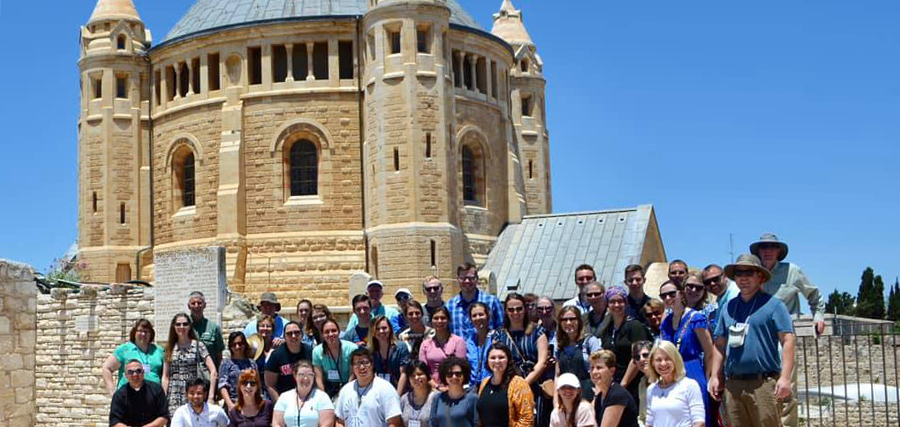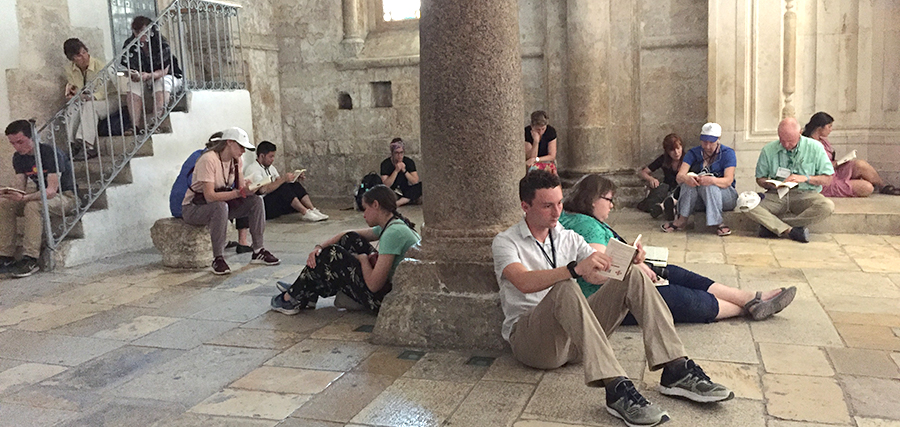
It can be hard to reflect on an experience that you’ve never had before.
Shortly after I began my employment at Tekton, I was tasked with writing a reflection on the Upper Room. Having never set foot in the same country as the Upper Room, I scoured the Internet for all the info it had to offer and prayed the good Lord would bless me with spiritual inspiration. Several searches and one corny joke about the Apostles using only one side of the table later (you can read it here), I ended up reflecting on how powerful it must be to stand in the exact spot as Jesus did when He first turned bread into His Body, how awe-inspiring it must be to trace the same humbled path as St. Thomas when he crossed the room to put his finger in the Lord’s wounded side. How immensely thrilling and soul-shaking it must be to occupy the same space that Jesus and His first disciples physically occupied!
Then, a year later, I was blessed to occupy that space as well.

When I entered the Upper Room, I couldn’t see Jesus and His Apostles being there – which is probably good because they wouldn’t have been. The original room has long since been captured, destroyed, and rebuilt – its latest purpose being an Islamic mosque before the Israeli government took over. The arching ceilings and stained-glass windows don’t quite fit the aesthetic of a poor carpenter and his fisherman friends, and the bouncing noise of the various visitors doesn’t lend to a place of worship and reflection. As I tried to tear away the new interior with my mind and put myself into the room that Jesus used – my group found itself miraculously alone in this space. Gone were the selfie sticks and chattering tourists, we had it all to ourselves. Each pilgrim retreated to a spot in the room, sat down, and contemplated (in silence!) the place we were in and the incredible history that happened in this very space. I myself found a short column against a wall and perched upon it as I surveyed my surroundings, waiting for that divine “God moment” that was going to strike my heart and leave me with a profound message.
Well, it didn’t. As I gazed about the room and read through the Gospels and reflections, nothing struck me. My mind was silent and the crickets were chirping. Several more minutes passed and, before long, I was being bumped out of my pseudo-meditation by a tourist who had just wandered in. The moment was over and my group filed out. I left without my desired divine inspiration.

The good thing about pilgrimage is that it doesn’t end when you fly home. It continues for the rest of your life, and it’s just as fruitful in 50 years as it is the day you arrive. As I was looking back at all the pictures that my fellow pilgrims were sharing upon returning to the US, I realized this:
It’s really incredible seeing 45 people collectively, reverently, and devoutly praying around the Upper Room.
This place where the priesthood was instituted, the first Mass was celebrated, the Holy Spirit descended and birthed the Catholic Church.
It’s amazing because as I look around that space filled with those familiar pilgrims, I realize that the Church isn’t contained within the walls of some long-disputed room. No, it’s living, and breathing, and totally awake and alive. It transforms all that it touches. It appears where two or more are gathered and it’s up to us to share it. Sure, it all began in this room, but the beautiful ending of that story is that the Holy Spirit came at Pentecost and allowed us to go out from there, creating a new beginning. The Lord is just as present (if not more) within the sanctuary of St. John’s in downtown Indianapolis as it is in His homeland. He’s not meant to be held captive in an ancient room.
And that’s the continued grace of going on a pilgrimage. Not that we go and just see these sacred things once, but that we bring them back with us for a lifetime. That we share them with those that haven’t experienced it. That we realize the Presence within all of us. That we transform our lives, our thoughts, and our parish with the experiences and messages that are shown to us – now and far into the future.



